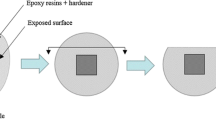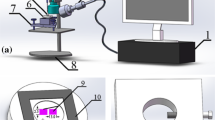Abstract
Electrochemical migration (ECM) characteristic is a new reliability failure. A parallel surfacial electrode system coupling with scanning electron microscope (SEM), energy dispersive X-ray analysis (EDAX), and X-ray Diffraction (XRD) technologies is designed to research ECM behavior of 64Sn-35Bi-1Ag (SBA) solder in 3.5 g/L NaCl solution and compare to that of Sn37Pb and Sn-3.0Ag-0.5Cu (SAC) solders. Results show that SBA solder is more susceptible to ECM failure than Sn37Pb solder, which is more difficult than SAC solder. The affected factors of ECM are given as follows: the solder compositions, the loaded electric field, ECM time, etc. The electrochemical reaction mechanism of ECM process is achieved. EDAX and XRD analyses show that the main contents on dendrites of SBA solder after ECM test are Sn, hardly any Bi, a little Ag, which illustrates that the order of ion migration capacity is shown as follows: Sn>Ag>Bi.
Similar content being viewed by others
References
Directive 2002/95/EC of the European Parliament and of the Council. On the restriction of the use of certain hazardous substances in electrical and electronic equipment [J]. Official Journal of the European Union, 2003, 23: 19–37.
Directive 2002/96/EC of the European Parliament and of the Council. On waste electrical and electronic equipment [J]. Official Journal of the European Union, 2003, 27: 24–37.
Xie Haiping, Yu Daquan, Ma haitao, et al. Microstructure, wettability and mechanical properties of Sn-Zn-Cu lead free solder [J]. The Chinese Journal of Nonferrous Metals, 2004, 14(10): 1694–1699.
Hua Li, Guo Xinpeng, Yang Jiakuan. Electrochemical corrosion behavior and dendrite growth of Sn-0.7Cu solder on FR-4 printed circuit board plated with Cu [J]. Journal of Chinese Society for Corrosion and Protection, 2010, 30(6): 469–474(Ch).
Bernard T, Bergmann H W, Haberling C, et al. Jointing technologies for Al-foam-Al-sheet compound structures [J]. Advanced Engineering Materials, 2002, 10(4): 798–802.
Yi L, Wong C P, Recent advances of conductive adhesives as a lead-free alternative in electronic packaging: Materials, processing, reliability and applications [J]. Materials Science Engineering, 2006, R51: 1–35.
Shin B L, Young R Y, Ja Y J, et al. Electrochemical migration characteristics of eutectic SnPb solder alloy in printed circuit board [J]. Thin Solid Films, 2006, 504: 294–297.
Tian Zongjun, Wang Guifeng, Huang Yinhui, et al. Fractal growth of Ni dendrite in electrodeposition [J]. The Chinese Journal of Nonferrous Metals, 2009, 19(1): 167–173(Ch).
Yu D Q, Jillek W, Schmitt E. Electrochemical migration of Sn-Pb and lead free solder alloys under distilled water [J]. Journal of Materials Science: Materials in Electronics, 2006, 17(3): 219–227.
Medqyes B, Illés B, Harsányi G, et al. Electrochemical migration behavior of Cu, Sn, Ag and Sn63/Pb37 [EB/OL].[2011-03-24]. http://www.springerlink.com/content/x50l383365514n75 .
Barsoum M W, Hoffman E N, Doherty R D, et al. Driving force and mechanism for spontaneous metal whisker formation [EB/OL]. [2011-05-12]. http://prl.aps.org/abstract/PRL/v93/i20/e206104 .
Oberndorff P, Dittes M, Crema P, et al. Whisker formation on matte Sn influencing of high humidity [EB/OL]. [2011-03-21]. http://www.engineeringvillage.com/controller/servlet/Controller?CID=quickSearchCitationFormat .
Osenbach J W, Delucca J M, Potteiger B D, et al. Sn-whiskers: Truths and myths [J]. Journal of Materials Science: Materials in Electronics, 2007, 18(1/3): 283–305.
Chen Shurong, Fractal Study About Dendrite on Metal Electrodeposition Process [D]. Kunming: Library of Kunming University of Science and Technology, 2002(Ch).
Chai Jiqing. Sn-Bi Alloy plating in a low molting point, Electroplating and Pollution Control, 1996, 16(4): 10–12(Ch).
Hua L, Yang G. K, Zhang H Q. Effects of Ge doping on electrochemical migration, corrosion behavior and oxidation characteristics of lead-free Sn-3.0Ag-0.5Cu solder for electronic packaging [J]. Advanced Materials Research: in Advances in Superalloys, 2011, 146–147: 953–961.
Li Zhuoran, Liu Bin, Feng Jicai. Optimum design of cadmium free siler-based filler metal contaed 20% Ag [J]. Transactions of The China Welding Institution, 2008, 29(8): 5–8(Ch).
Wei Guoqiang, Wan Zhonghua, Zhao Siyong, et al. Investigations on melting property, wettability and Mechanical property of Sn-XAg-0.5Cu lead-free solder alloys [J]. Material Science, 2010, 10: 53–56(Ch).
Liu Jing, Xu Jun, Zhang Fuwen, et al. Property of new type lead-free solder Sn-Ag-Cu-Cr-X [J]. Rare Metals, 2005, 29(5): 625–630(Ch).
Hua Li, Guo Xingpeng, Yang Jiakuan, Effects of Bi doping on electrochemical corrosion and dendrite growth suppression of lead-free Sn-3.0Ag-0.5Cu solder [J]. The Chinese Journal of Nonferrous Metals, 2011, 51: 2274–2283(Ch).
Yang D, Chan Y C, Wu B Y, Electromigration and thermomigration behavior of flip chip solder joints in high current density packages [J]. Journal of Materials Research, 2008, 23(9): 2333–2339.
Huang A T, Gusak A M, Tu K N, Thermomigration in SnPb composite flip chip solder joints [J]. Applied Physics Letters, 2006, 88(14): 1–3.
Author information
Authors and Affiliations
Corresponding author
Additional information
Foundation item: Supported by the National Natural Science Foundation of China (NSFC)(51171068), the Vital Fund from Hubei Provincial Department of Education ( C2010071), and the Fund of the Vital Subject Program on Applied Chemistry in Hubei University of Education
Biography: HUA Li, female, Post doctoral, Associate professor, research direction: new nanometer functional materials, the reliability and serve failure researches in micro/nanoelectronic packaging.
Rights and permissions
About this article
Cite this article
Hua, L., Hou, H. Electrochemical migration behaviors of lead-free 64Sn-35Bi-1Ag solder on FR-4 PCB board plated with Cu. Wuhan Univ. J. Nat. Sci. 17, 79–85 (2012). https://doi.org/10.1007/s11859-012-0808-5
Received:
Published:
Issue Date:
DOI: https://doi.org/10.1007/s11859-012-0808-5




